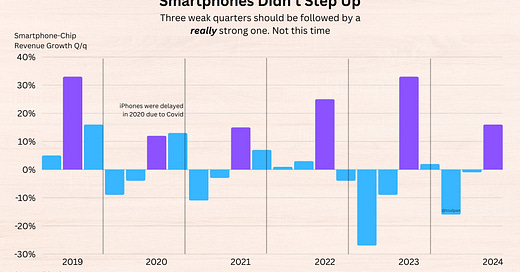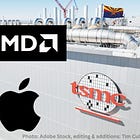TSMC Earnings Show Apple's Desperate Plight
[Opinion] Strength in AI may be masking weakness in smartphones, and at the foundry's largest customer
Good Evening from Taipei,
“Today, without AI the market would be very sad.”
Those are the words of ASML CEO Christophe Fouquet. The only supplier of leading-edge semiconductor lithography equipment on Wednesday (well, oops, Tuesday) announced some pretty solid revenue numbers. But the Dutch company broke investors’ hearts when it forecast bookings for the coming quarter that were really bad — around half what had been expected. In the capital-equipment business, revenue measures what you build and ship that quarter, while bookings foreshadow what’s coming down the pike.
Intel’s slow-moving trainwreck and troubles at Samsung were two major contributors. China’s previous rush to buy chipmaking equipment ahead of more Western bans resulted in a hangover, and that then weighed on sentiment for the future. Revenue from China will be structurally lower going forward. But at least AI is keeping chip demand alive, and thus puts a floor under sales of the Dutch company’s chipmaking equipment.
ASML is three degrees away from the end consumer. It’s largest client, TSMC, is two degrees away. Apple, TSMC’s largest customer, is one degree away. I believe that what we saw from TSMC on Thursday shows real weakness at Apple and its consumers. But you need to dig deep to find it.
TSMC reported its third-quarter numbers Thursday afternoon, Taipei time, then followed up with an hour-long investor call. Revenue was in line with expectations — it beat guidance, but then it always does. While gross margin, at 57.8%, was 2.3ppt higher than the top end of its guidance — that’s huge. Higher capacity utilization is the key reason. TSMC’s biggest cost is depreciation. When its fabs are used less its margins shrink, and vice versa.
Higher electricity prices and the introduction of new process technologies weighed on profitability, but not by much compared to the upside from higher utilization. Low-volume, low-yield production, when TSMC is in the learning phase, results in high costs but not much revenue, so gross margin shrinks. But when the company hits its stride on a new node, we see the opposite.
Other good news from TSMC included a tightening of its 2024 capex figure, coming in at close to $30 billion. It had originally forecast $28 billion to $32 billion, then narrowed it to $30 billion to $32 billion. With spending at only $18.5 billion year-to-date and ASML’s nasty surprise on bookings, there was a realistic fear that TSMC could cut. Not only did it not cut its capex, the Hsinchu Shark forecast spending next year will be even higher.
If there’s anything for ASML to take away from TSMC’s IR call today, it’s that long-term prospects are good — at least with respect to business from ASML’s largest customer. But there’s not much TSMC can do for ASML if Intel and Samsung keep struggling, and CEO CC Wei gave no indication that the Taiwanese foundry is picking up any business lost by Intel’s ongoing problems and Samsung’s slip ups.
In the other direction — customer facing — an upgrade to the full-year sales forecast — equivalent to around $2 billion more revenue than previously expected —is rather good. But only for TSMC, and those customer(s) that are doing better. TSMC kept its full-year industry (ex-memory) forecast unchanged at 10% revenue growth. Mathematically, that means others are suffering more than previously thought.
What we also know is that in the AI realm, “demand right now is insane.” That’s CC Wei citing an unnamed customer — one might guess its name starts with N. One analyst asked what many others have been thinking: Is this AI demand real? As in, is the end-demand for AI services enough to support all the money spent on AI chips and servers?
“Almost every AI innovator is working with TSMC. So we’ve probably got the deepest and widest look of anyone in this industry,” Wei responded. “My judgement is it’s real.” He then made a convincing case for long-term structural strength in the AI hardware market which can be summarized as: AI boosts productivity, so end customers will keep buying.
It does not, however, look like Apple’s end customers are continuing to buy. CC Wei sought to allay concerns over the PC and smartphone market, noting that “unit growth of PCs and smartphones is low-single digit” percent but there’ll be more silicon per unit, especially as on-device AI comes in.
The most-recent set of data indicates this upside hasn’t occurred yet. Revenue from TSMC’s smartphone segment climbed 16% from the prior quarter. That’s terrible. Third-quarter is peak iPhone season. Smartphone-chip revenue weakens in 1Q and again in 2Q before rebounding so strongly in 3Q that the prior two quarters of decline are erased. That’s the rule, that’s how cyclicality is supposed to work. Last year the third-quarter growth figure was 33% and the year before quarter-on-quarter growth for the September period was 25%.
That didn’t happen this year. By my calculation, TSMC’s revenue from smartphones last quarter was 14% to 20% lower than the same period two years prior. Revenue in the high-performance computing segment, which includes AI GPUs and CPUs, is 63% higher over the same period. It is possible that we get a nice boost in 4Q, but my data indicates a jump of 20% quarter-on-quarter is needed to get the smartphone sector back on track. Possible, but given how things are tracking — no upgrade to the industry-wide forecast and only a few points higher for TSMC revenue — this doesn’t seem likely.
But at least we have AI. Because, as Fouquet said, without it we’d be very sad.
Thanks for reading.









Is it possible that demand for and from Apple is low because despite their marketing, Apple hasn’t started shipping their generative AI features and thus consumers haven’t bought Apple products that have generative AI features?
On the other hand, Apple should have had an uptick in server purchases, even if they’re modified versions of Apple’s desktops/workstations.
On a third hand, inflation is high in the United States right now and we’re coming up to the end of an election cycle. If consumers are out of money and businesses have suspended hiring until after the election or the new year, chips could be slow going until roughly Valentine’s Day or end of calendar Q1 2025.